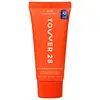What's inside
What's inside
 Key Ingredients
Key Ingredients

 Benefits
Benefits

 Concerns
Concerns

No concerns
 Ingredients Side-by-side
Ingredients Side-by-side

Water
Skin ConditioningGlycerin
HumectantCetyl Ethylhexanoate
EmollientCaprylic/Capric Triglyceride
MaskingPropanediol
Solvent1,2-Hexanediol
Skin ConditioningGlyceryl Stearate
EmollientCetearyl Alcohol
EmollientMicrocrystalline Cellulose
AbsorbentSodium Polyacrylate Starch
AbsorbentSclerotium Gum
Emulsion StabilisingTriolein
Skin ConditioningPotassium Cetyl Phosphate
EmulsifyingBehenyl Alcohol
EmollientAllantoin
Skin ConditioningCeramide NP
Skin ConditioningGlyceryl Dioleate
EmollientCellulose Gum
Emulsion StabilisingSodium Phytate
Pentylene Glycol
Skin ConditioningSodium Acetylated Hyaluronate
HumectantSodium Hyaluronate
HumectantSodium Hyaluronate Crosspolymer
HumectantHydrolyzed Sodium Hyaluronate
Skin ConditioningEthylhexylglycerin
Skin ConditioningWater, Glycerin, Cetyl Ethylhexanoate, Caprylic/Capric Triglyceride, Propanediol, 1,2-Hexanediol, Glyceryl Stearate, Cetearyl Alcohol, Microcrystalline Cellulose, Sodium Polyacrylate Starch, Sclerotium Gum, Triolein, Potassium Cetyl Phosphate, Behenyl Alcohol, Allantoin, Ceramide NP, Glyceryl Dioleate, Cellulose Gum, Sodium Phytate, Pentylene Glycol, Sodium Acetylated Hyaluronate, Sodium Hyaluronate, Sodium Hyaluronate Crosspolymer, Hydrolyzed Sodium Hyaluronate, Ethylhexylglycerin
Water
Skin ConditioningGlycerin
HumectantHydrogenated Ethylhexyl Olivate
EmollientHydrogenated Olive Oil Unsaponifiables
EmollientDicaprylyl Carbonate
EmollientSodium PCA
HumectantGlyceryl Stearate
EmollientCaprylic/Capric Triglyceride
MaskingOctyldodecanol
EmollientRibes Nigrum Seed Oil
EmollientHelianthus Annuus Seed Oil Unsaponifiables
EmollientCardiospermum Halicacabum Flower/Leaf/Vine Extract
Skin ConditioningVetiveria Zizanoides Root Extract
PerfumingCoconut Alkanes
EmollientCoco-Caprylate/Caprate
EmollientOctyldodecyl Myristate
EmollientCapparis Spinosa Fruit Extract
Skin ConditioningPotassium Cetyl Phosphate
EmulsifyingInulin
Skin ConditioningAlpha-Glucan Oligosaccharide
CleansingTocopherol
AntioxidantLactobacillus Ferment
Skin ConditioningHydrolyzed Hyaluronic Acid
HumectantMaltodextrin
AbsorbentCaprylyl Glycol
EmollientGlyceryl Caprylate
EmollientPhenylpropanol
MaskingCarbomer
Emulsion StabilisingSodium Phytate
Potassium Sorbate
PreservativeSodium Lactate
BufferingWater, Glycerin, Hydrogenated Ethylhexyl Olivate, Hydrogenated Olive Oil Unsaponifiables, Dicaprylyl Carbonate, Sodium PCA, Glyceryl Stearate, Caprylic/Capric Triglyceride, Octyldodecanol, Ribes Nigrum Seed Oil, Helianthus Annuus Seed Oil Unsaponifiables, Cardiospermum Halicacabum Flower/Leaf/Vine Extract, Vetiveria Zizanoides Root Extract, Coconut Alkanes, Coco-Caprylate/Caprate, Octyldodecyl Myristate, Capparis Spinosa Fruit Extract, Potassium Cetyl Phosphate, Inulin, Alpha-Glucan Oligosaccharide, Tocopherol, Lactobacillus Ferment, Hydrolyzed Hyaluronic Acid, Maltodextrin, Caprylyl Glycol, Glyceryl Caprylate, Phenylpropanol, Carbomer, Sodium Phytate, Potassium Sorbate, Sodium Lactate
 Reviews
Reviews

Ingredients Explained
These ingredients are found in both products.
Ingredients higher up in an ingredient list are typically present in a larger amount.
This ingredient is an emollient, solvent, and texture enhancer. It is considered a skin-softener by helping the skin prevent moisture loss.
It helps thicken a product's formula and makes it easier to spread by dissolving clumping compounds.
Caprylic Triglyceride is made by combining glycerin with coconut oil, forming a clear liquid.
While there is an assumption Caprylic Triglyceride can clog pores due to it being derived from coconut oil, there is no research supporting this.
Learn more about Caprylic/Capric TriglycerideGlycerin is already naturally found in your skin. It helps moisturize and protect your skin.
A study from 2016 found glycerin to be more effective as a humectant than AHAs and hyaluronic acid.
As a humectant, it helps the skin stay hydrated by pulling moisture to your skin. The low molecular weight of glycerin allows it to pull moisture into the deeper layers of your skin.
Hydrated skin improves your skin barrier; Your skin barrier helps protect against irritants and bacteria.
Glycerin has also been found to have antimicrobial and antiviral properties. Due to these properties, glycerin is often used in wound and burn treatments.
In cosmetics, glycerin is usually derived from plants such as soybean or palm. However, it can also be sourced from animals, such as tallow or animal fat.
This ingredient is organic, colorless, odorless, and non-toxic.
Glycerin is the name for this ingredient in American English. British English uses Glycerol/Glycerine.
Learn more about GlycerinGlyceryl Stearate is a mix of glycerin and stearic acid.
It is used to stabilize the mixing of water and oil ingredients. By preventing these ingredients from separating, it can help elongate shelf life. It can also help thicken the product's texture.
As an emollient, it helps soften skin and supports barrier-replenishing ingredients.
In cosmetics, Glyceryl Stearate is often made from vegetable oils or synthetically produced.
This ingredient may not be fungal-acne safe
Fun fact: The human body also creates Glyceryl Stearate naturally.
Learn more about Glyceryl StearatePotassium Cetyl Phosphate is the potassium salt of a mixture. This mixture consists of the esters from phosphoricacid and cetyl alcohol.
Potassium Cetyl Phosphate is an emulsifier and cleansing agent. Emulsifiers help stabilize a product. It does this by preventing certain ingredients from separating.
As a cleansing agent, Potassium Cetyl Phosphate helps gather oils, dirts, and pollutants from your skin. This makes it easier to rinse them away with water.
Learn more about Potassium Cetyl PhosphateSodium Phytate is the synthetic salt form of phytic acid. Phytic acid is an antioxidant and can be found in plant seeds.
Sodium Phytate is a chelating agent. Chelating agents help prevent metals from binding to water. This helps stabilize the ingredients and the product.
Water. It's the most common cosmetic ingredient of all. You'll usually see it at the top of ingredient lists, meaning that it makes up the largest part of the product.
So why is it so popular? Water most often acts as a solvent - this means that it helps dissolve other ingredients into the formulation.
You'll also recognize water as that liquid we all need to stay alive. If you see this, drink a glass of water. Stay hydrated!
Learn more about Water